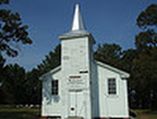Kehukee Baptist Association
 The Kehukee Baptist Association was formed in the eighteenth century by Baptist churches in eastern North Carolina that had belonged to the Charleston Baptist Convention but decided, because of distance and divergent interests, to form their own association. The actual date of the formation is now accepted as 1769. These churches were initially considered General Baptists and followed a doctrine aligned with Arminian (General Baptist) ideology. They gradually moved to a strong Calvinist (Regular Baptist) position under the leadership of Lemuel Burkitt. The association grew to include all eastern North Carolina Baptists until around 1806.
The Kehukee Baptist Association was formed in the eighteenth century by Baptist churches in eastern North Carolina that had belonged to the Charleston Baptist Convention but decided, because of distance and divergent interests, to form their own association. The actual date of the formation is now accepted as 1769. These churches were initially considered General Baptists and followed a doctrine aligned with Arminian (General Baptist) ideology. They gradually moved to a strong Calvinist (Regular Baptist) position under the leadership of Lemuel Burkitt. The association grew to include all eastern North Carolina Baptists until around 1806.
The Kehukee Association was modeled on the Philadelphia Association and adopted the strongly Calvinistic Philadelphia Confession. Members of the Philadelphia Association became known as Particular Baptists, so called because they believed in "limited atonement," holding that only a few people would be saved and those people had already been selected by God. During the Revolutionary War, the Kehukee Association divided into two groups over the question of accepting as church members those who had been baptized "in unbelief." The dissidents, led by Burkitt, who wanted the more restrictive membership requirement, joined in 1789 with churches across the Virginia line to form a new association, which was called the United Baptist Association. The new association contained several Separate Baptist and several Regular Baptist churches-something new in Baptist history-and claimed a total of 61 churches in North Carolina and Virginia. It adopted a Confession of Faith that was again strongly Calvinistic.
With the growth of the general population, the Kehukee Association grew also. It reached a membership of approximately 37 churches and 2,000 congregants by 1900. During the nineteenth century the antimissionary, or Primitive, Baptists had spread thinly across North Carolina, claiming several associations in the north central part of the state and in the mountains. Primitive Baptist churches nationwide reached about 3,000 in number, with 120,000 members by 1900, but these numbers had declined somewhat by the latter decades of the twentieth century.
References:
Maloy A Huggins, A History of North Carolina Baptists, 1727-1932 (1967).
George Washington Paschal, History of North Carolina Baptists (2 vols., 1938).
Additional Resources:
NC Historical Markers, Lemuel Burkitt: http://www.ncmarkers.com/Markers.aspx?MarkerId=E-42
NC Historical Markers, The Kehukee Association: http://www.ncmarkers.com/Markers.aspx?MarkerId=E-71
Owens, Jesse. "English General Baptists: The Arminian Anti-rationalists (Part I/II)." Hewley's Society Forum. October 23, 2017. Accessed June 23, 2023 at https://www.helwyssocietyforum.com/english-general-baptists-the-arminian-anti-rationalists-part-iii/.
"Reformation of the Kehukee Association." The Reformed Reader. Accessed June 23, 2023 at https://www.reformedreader.org/history/ivey/ch09.htm.
Shelley, Bruce L. "Baptist Churches in U.S.A." In Dictionary of Christianity in America, edited by Daniel G. Reid, et al., 110-114. Downers Grove, IL: InterVarsity Press, 1990. Accessed June 27, 2023 at https://archive.org/details/dictionaryofchri0000unse_n6x8/mode/2up.
Image Credit:
Kehukee Primitive Baptist Church, NC Historical Marker E-71. Image courtesy of NC Office of Archives & History. Available from https://www.ncdcr.gov/about/history/division-historical-resources/nc-highway-historical-marker-program/ (accessed June 8, 2012).
1 January 2006 | Moore, Anne